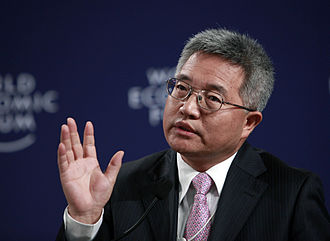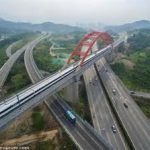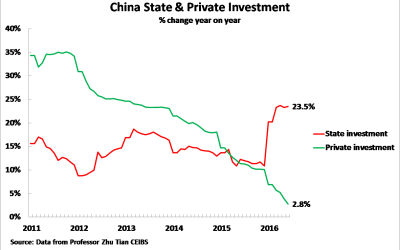Zhang made the usual neo-liberal claims, which are entirely contrary to the facts, that it was spontaneous operation of the market which created economic development and the best policy for the state was to stay out of the economy as much as possible. To do this Zhang was forced to wildly falsify history – claiming that Britain at the time of the Industrial Revolution was a ‘border island’ and US economic growth was due to spontaneous operation of the market. In reality by the time of the Industrial Revolution Britain was the strongest European state, with the most important Empire, having defeated France in almost a century of world wide warfare, while US industrialisation was carried out behind massive state tariff protectionism. The fact neo-liberalism, in order to try to defend its views, had to falsify world history is, of course, because neo-liberalism is contradicted by the facts.
Because if a theory and reality do not coincide only one of two things can be done. A sensible person abandons the theory, a dangerous one abandons reality. Neo-liberalism is a classic case of abandoning reality because it does not fit with your (false) theory.
My contribution to this debate in China was to clarify the real facts of British and US history – as shown in the article below. Although this discussion was in China it is relevance to the errors of neo-liberalism everywhere
In his article ‘Lin Yifu’s four errors on industrial policy’ [1] Zhang Weiying attempts to defend his opposition to industrial policy. Lin Yifu himself deals with the contemporary issues of China’s economic policy, but Zhang Weiying either does not know, or consciously misrepresents, elementary facts of Western economic history. It was astounding to read this statement:
‘In human history, the real economic growth in the United States and Britain should be seen as a miracle. Since the Industrial Revolution the United Kingdom went from a border island to a leader of modern human civilization. The United States went from a country where before the Civil War more than 80% of the population was rural and agricultural to become by 1890, thirty years later, one of the world’s largest industrial countries.’ [2]
The statement Britain at the time of the Industrial Revolution, was a ‘border island’ is historically the exact reverse of the truth. Britain, even before the Industrial Revolution was already the most powerful state in Europe and probably the world – the only potential alternative at that time being declining Qing dynasty China. This was demonstrated in the most direct and irrefutable fashion – Britain defeated France, the other great European power of the period, during almost a century of worldwide wars waged not only in Europe but in India, the Caribbean and North America – the Nine Years’ War (1688–97), War of the Spanish Succession (1702-1714), War of the Austrian Succession (1740-1748), the Seven Years War (1756-1763). By the time of the Industrial Revolution Britain had created the core of the world’s largest Empire, ‘on which the sun never set’– including in India, Australasia, Canada and large parts of Africa. The characterisation of the proven victor, in what were in reality the first ‘world-wide wars’ in history, as a ‘border island’ is truly extraordinary – a complete fabrication.
Neither is there any mystery as to the reasons for the US unparalleled growth after its Civil War, when it overtook the UK as the world’s largest economy. The US rise to global economic dominance was based on gigantic quantitative accumulation of labour and capital.
Between 1860 and 1890, spurred by massive immigration, the US population almost doubled from 31.8 million to 63.3 million. In contrast in the same period the UK population increased by only 30%. In 1860 the US population was three million higher than the US, by 1890 it was 26 million higher – the US population went from 110% of the UK to 169% of the UK.
Simultaneously the US percentage of fixed investment in GDP rose to far above any level that had previously been achieved by the UK, the former economic ‘superpower’. The highest UK annual percentage of GDP devoted to fixed investment prior to World War I was only 10.6%, compared to a US maximum of 21.8%. As Maddison summarised:
‘The rate of US domestic investment was nearly twice the UK level for the sixty-year period 1890-1950. Its level of capital stock per person employed was twice as high as that of the UK in 1890, and its overwhelming advantage in this respect over all other countries continued until the early 1980s.’
Over the period 1860 to 1890 US GDP grew from approximately 20% smaller than that of the UK to 30% larger. A small part of this was due to the fact that the US slightly narrowed the UK lead in per capita GDP, from approximately thirty per cent to approximately twenty per cent, but the most fundamental quantitative reason was the gigantic US accumulation of capital and labour.
How UK & US growth was achieved
Turning to the policies achieving UK and US economic growth during their respective periods of economic dominance they were based on massive state action, not a ‘free market’.
The feature of the UK, during its period of rise to world economic dominance, was enormous state borrowing and expenditure – chiefly undertaken to finance the warfare required to create the world’s largest empire. By 1763 UK state debt reached over 150% of GDP and by 1815 UK state debt was over 250% of GDP.
The US, during its rise to global dominance, used state intervention to create one of the world’s most protectionist tariff regimes. These high tariffs were deliberately designed to protect the development of industry in the northern US states. US tariff protectionism began in 1789 immediately after adoption of the US Constitution. For the next seventy years US tariffs fluctuated somewhat as a struggle existed between the southern US states, which were not industrialised and therefore not so concerned with tariff protection, and the northern industrialised states. But after the North’s Civil War victory its interests were imposed in sustained high state trade tariffs. By 1870 the average US tariff on imports was 45% and it remained above 27% until 1910.
If the UK rose to world economic dominance accompanied by massive state borrowing, the rise of the US to global economic dominance by World War I was not by ‘free market’ methods but constructed behind a state wall of tariffs.
Western growth model
Turning from economic causes to economic results simple arithmetic shows that copying Western economic growth models would condemn China to permanently lag far behind the advanced economies.
The data shows that the UK/US economic model is based on very slow growth sustained over centuries. From 1900-2015 average annual per capita US GDP growth was only 1.9% and the UK was 1.5%. While calculations for the 19th century are more approximate it is clear that in the 19th century UK/US growth was even slower than in the 20th and 21st – from 1820-2015 US per capita GDP growth was 1.7% and the UK 1.4%.
The picture, sometimes presented in parts of the media, that the Western economies at some point in the past grew fast in a sustained way and have now ‘slowed’ is simply false. Taking the last 20 years 1995-2015, then US per capita GDP growth at 1.4% is only slightly below its very long term average and the UK’s 1.7% is slightly above it. Far from the US and UK significantly slowing as they became more advanced, the US and UK were already growing very slowly when they had levels of per capita GDP significantly below China’s present one.
As US/UK growth models have always produced very low growth rates, if China were to adopt such a Western model it would equally have a very slow growth rate. This would mean China abandoning the possibility to become a high income economy for many years, and to China abandoning for very many decades, probably permanently, the attempt to catch up with the living standards of the West. Such a policy would be ridiculous when China’s economic model has produced sustained growth rates many times faster than the UK or US ever achieved.
Real history of the US
While the facts regarding the methods which enabled the US to overtake the UK prior to World War I have already been analysed there is equally no doubt which methods raised the US to its true ‘economic superpower’ status by the end of World War II. The facts are set out in detail in my book The Great Chess Game (一盘大棋?中国新命运解析) so it is merely necessary to summarize the key points here.
‘Between 1939 and 1945 US GDP expanded by 91% – an annual average 11% growth. Between 1939 and the last full year of war in 1944 annual US economic expansion averaged 14% – the fastest economic growth ever achieved in a major economy over a five-year period in history… By 1945, despite the intervening Great Depression, the US economy had more than doubled in size compared to 1929. It was therefore, without ambiguity… the World War II US economy which explained the United States unparalleled position of global economic dominance in the immediate post-World War II period.
‘Once again, the cause of this previously unprecedented US e
conomic growth is clear: it was led by gigantic state expenditure. Between 1938 and 1945 US household consumption rose by 30%, and private investment rose by 12%. But US state expenditure rose by 553%. Measured in 1937 prices, 82% of the increase in US GDP between 1938 and 1945, the fastest period of growth in US economic history, was accounted for by government expenditure….
‘The consequence was that the US state largely took over from the private sector as the driving force of fixed investment – by 1943 83% of US fixed investment was carried out by the state. The reality is, therefore, that the most rapid period of expansion in US economic history, the one which established it as the undisputed economic superpower, was driven not by private but by state investment.
‘In conclusion, the establishment by the US of an unparalleled position of international economic dominance, and the fastest period of growth in US history, all of which laid the basis for the definitive emergence as the US as economic superpower of the second half of the 20th century, was not achieved by the private sector but by a huge state spending boom! It was the ‘visible’ hand, not the ‘invisible’ one that propelled the US to a position of unparalleled global economic dominance.’
State industrial policy
The UK in the 19th century, and the US in the 20th, were the largest economies, and the most powerful industrial states, which had existed in history. Therefore, misrepresentation, or lack of knowledge, of their development necessarily presents a distorted and inaccurate version of the entire history of economic growth. Compared to errors by Zhang Weijying on the entire course of world economic history wrong positions on industrial policy are therefore rather small in comparison. Nevertheless, these errors are related therefore worth dealing with. Once more the factual issues have been deal with thoroughly in The Great Chess Game and may therefore be summarised here.
‘As Martin Wolf, chief economics commentator of the Financial Times, put it reviewing Mazzucato’s study The Entrepreneurial State:
‘innovation depends on bold entrepreneurship. But the entity that takes the boldest risk and achieves the biggest breakthroughs is not the private sector; it is the… state…
‘The US National Science Foundation funded the algorithm that drove Google’s search engine. Early funding for Apple came from the US government’s Small Business Investment Company. Moreover, “All the technologies which make the iPhone ‘smart’ are also state-funded … the internet, wireless networks, the global positioning system, microelectronics, touchscreen displays and the latest voice-activated SIRI personal assistant.” Apple put this together, brilliantly. But it was gathering the fruit of seven decades of state-supported innovation.
‘Because of the high cost of very large scale R&D, and the uncertainty of its outcome and time scale, i.e. the high costs of expanding the technological frontier as opposed to adopting or improving already proven technologies, it is the state which plays a decisive role in fundamental innovation. As Wolf concludes:
“Why is the state’s role so important? The answer lies in the huge uncertainties, time spans and costs associated with fundamental, science-based innovation. Private companies cannot and will not bear these costs, partly because they cannot be sure to reap the fruits and partly because these fruits lie so far in the future.
Indeed, the more competitive and finance-driven the economy, the less the private sector will be willing to bear such risks…. In any case, the private sector could not have created the internet or GPS. Only the US military had the resources to do so. “’
Therefore, as Mazzucato analyses in detail regarding Apple:
‘all of the technologies that make Jobs’ iPhone so “smart” were government funded (Internet, GPS, touch-screen display and the recent SIRI voice activated personal assistant). Such radical investments – which embedded extreme uncertainty – did not come about due to the presence of venture capitalists, nor of “garage tinkerers”. It was the visible hand of the State which made these innovations happen. Innovation that would not have come about had we waited for the “market” and business to do it alone – or government to simply stand aside and provide the basics.
This is precisely the point Lin Yifu notes in general terms regarding the overall US lead in R&D:
‘The ongoing debate over the need for a US industrial policy has not changed the hard facts about the important role played by the federal and state governments in industrial development in recent decades. Their interventions include the allocation of large amounts of public funding to defence-related procurements and R&D spending, which have large spillover effects throughout the economy.’
Quantitatively, as Lin notes:
‘As Chang observes, “industries such as computers, aerospace and the internet, where the U.S.A. still maintains an international edge despite the decline in its overall technological leadership, would not have existed without defence-related R&D funding by the country’s federal government’. Government support is also critical in other important segments of the economy such as the health industry: public funding to the National Institutes of Health, which in turn support a large fraction of R&D by biotechnological firms, has been essential in helping the US maintain its lead in that industry.’
Why?
Why, therefore, are such extraordinarily inaccurate statement made as that Britain at the time of the Industrial Revolution, was a ‘border island’? And why no mention of the huge US quantitative accumulation of capital and labour, protected by state imposed tariff walls, by which it became the world’s most powerful economy?
It is because if facts and a theory do not coincide there are only one of two courses that can be taken. The first, the correct one, demanded both by the Chinese dictum ‘seek truth from facts’ and the basis of science, is that if the theory and the facts don’t coincide then the theory must be abandoned as wrong. The second, which rejects science, is that if the facts and the theory don’t fit then the facts must be ignored. However this is a method which proves the theory is wrong. But lack of knowledge of, or misrepresentation, of the history of the two dominant economies in the last two centuries of world history, the US and the UK, is a particularly extreme case of attempting to ignore facts to support a wrong theory.
The issue is extremely serious. If facts are suppressed in order to attempt to justify a false theory in a university seminar the main thing that is damaged is the student’s knowledge. If facts are suppressed in order to attempt to justify a wrong theory in China’s economic policy making, in the world’s second largest economy, then the lives of 1.3 billion people will be damaged and China’s national rejuvenation seriously setback.
Notes
[1] 林毅夫在产业政策问题上的四个错误
[2] 人类历史上真正的经济增长奇迹应该是英国和美国。由于工业革命,英国从一个边陲岛国成为人类现代文明的引领者。美国则从一个南北战争之前80%以上人口都在农村的农业国家,在三十年后的1890年成为世界第一大工业国。







